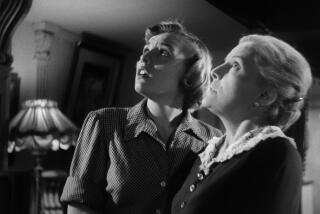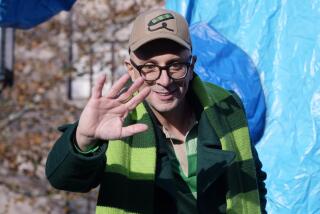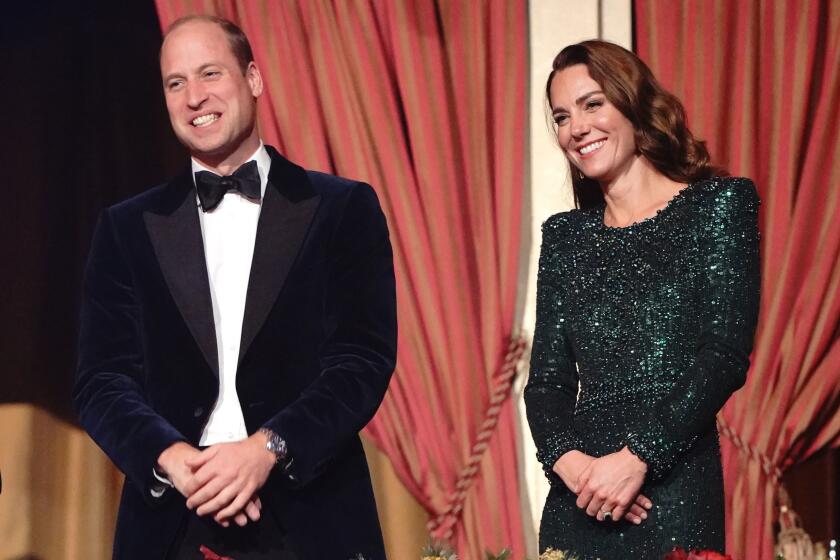That Burns backlash
The documentary filmmaker Ken Burns has a story he clearly loves to tell. He was walking in New York City a few years ago -- on a date -- when he heard a man he’d just passed yell violently back at him: “What about Mingus?!” Preceding the name of the protean jazz bassist was a pungent (and unprintable) expletive.
Burns turned to his date and reassured her. “It’s just about ‘Jazz,’ ” he said, referring to his 10-part history shown on PBS in 2001, which drew big audiences and critics’ complaints that he overlooked key figures.
But Burns had to laugh, privately: Charles Mingus actually had a substantial role in the program: His critic, Burns concludes, must have taken an ill-timed bathroom break.
Burns, 56, laughs good-naturedly about it now, and the phrase “What about [expletive] Mingus?!” has became a kind of mantra to him when he’s accused of various narrative or cinematic crimes.
The filmmaker may need to keep this phrase handy in the next few weeks, as his new six-part documentary program -- “The National Parks: America’s Best Idea” -- unrolls on PBS stations. While Burns is one of the best known and most watched documentarian of recent times, he has also acquired his share of detractors. Though he’s generally respected by critics and scholars, a backlash has been building, dismissing him as middlebrow, charging that he’s repeating himself, that he’s too earnest, too dark or naively patriotic.
“The National Parks” will open in a far less welcoming environment than the one that greeted his breakout work, “The Civil War,” in 1990.
Burns himself is confident, keyed up and personable when he talks about his projects. For “The National Parks,” he engagingly quotes John Muir and Thomas Jefferson. His claims are both gracious and overreaching: “We think this film is the Declaration of Independence applied to the landscape,” he says, in blue blazer and hiking boots during an interview this summer at Pasadena’s Langham Huntington Hotel.
And it’s clear he feels the beauty of, say, Yosemite: “These places are not just as they were 150 years ago, when John Muir walked in, but 15,000 years ago when the ancestors of the Ahwahneechees first laid eyes on them,” he says, referring to a Native American tribe.
With his enthusiasm, practiced patter and clear commitment not just to visual images but to ideas themselves, it’s easy to imagine him walking into a room of potential underwriters or public broadcasting executives and knocking them dead.
Some of the criticisms Burns attracts are of the “What about Mingus?” variety. But others take aim at his central claim: that his cinematic subjects embody the American spirit, and that our democracy is unique in the world. For example, jazz is presented in his documentary as a mirror for our democracy, with the suggestion that American culture is all about improvisation.
“This sort of unreflected populist Hallmark-ese seems a strange mixture of New Deal and New Age,” Tim Page wrote in the Washington Post around the time of “Jazz,” “and I don’t believe it for a moment.”
By now, the combination of a deep, authoritative male voice, pan-and-zoom camera work over sepia-toned photographs, period music and extravagant claims about American exceptionalism have become well-known. Apple even calls a function on its iPhoto program “The Ken Burns Effect.”
Of course, no artist reaches Burns’ level of success and ubiquity without criticism. But there may be something about the filmmaker, and the size and scope of his projects, that earns him a special kind of antipathy, whether it’s little digs on “The Simpsons” or jokes about his distinctive haircut.
Burns founded his company, Florentine Films, in 1976, just a year out of Hampshire College; in the ‘80s he made films about the Statue of Liberty, painter Thomas Hart Benton and other subjects. But his first stab at world domination came with “The Civil War.” That five-part, 11-hour series, narrated by David McCullough, sought to establish that conflict was the key to American character.
Burns says criticism was strong even then.
“I have always been thrilled,” he says, “by the extreme left, the Marxist historians, who consider the film to be hagiography about Lincoln, with not enough on the radical Congress. Legitimate. And those on the extreme right who persist in believing that this is about states’ rights and not about slavery. They’re wrong.
“But when you’ve got one percent on each fringe, and 40 million people -- the highest ratings PBS had ever had -- and then later with ‘Baseball’ the same thing, you realize, this is what happens. . . . It was great! It just brought more attention.”
--
The Burns formula
Despite the carping, “The Civil War” is considered Burns’ masterpiece, the subsequent films regarded as flawed each in their own way, following too closely the “Civil War” formula.
The reception of the most recent large-scale Burns film -- smaller ones have chronicled the life of boxer Jack Johnson and the journeys of Lewis and Clark -- hint at the sharp knives that could greet “The National Parks.”
“The War,” a World War II chronicle concentrating on four soldiers, provoked criticism beyond academia and the press when it was broadcast in 2007: It drew complaints from Latino and Native American groups that their war veterans were overlooked, and Burns changed the film to accommodate his critics.
Critical reception was hardly unanimous. “World War II didn’t happen just to us,” Alessandra Stanley led a New York Times review, “particularly now, as the conflict in Iraq unravels, this degree of insularity -- at such length and detail -- is disconcerting. . . . Certainly the men and women serving in uniform at the time were more curious about other fronts than Mr. Burns is.”
The images were better than the history, Rick Atkinson wrote in the Washington Post. He is the author of two recent books on World War II. “There is little substantive analysis, about the war or its many subplots,” Atkinson wrote. Noting some errors in fact, one of them concerning the Allies’ Italian strategy, he concluded, “The truth is more nuanced, and far more intriguing.”
Looking over the critical reaction to Burns, it makes sense to ask: Why so much criticism, and why is it so sharp?
It may be that, especially in a country famously impervious to history -- where it’s hard, for instance, to find classes on jazz in high schools -- Burns’ vision of the American past can feel like the only public voice.
Marina Goldovskaya, a cinematographer who teaches documentary film at UCLA, places Burns in a specific tradition: He’s in the line of American directors such as Pare Lorentz, who made civic-minded films in the ‘30s for President Roosevelt, and British filmmakers who worked under John Grierson in the same decade to make what she calls “films to enlighten people, to explain how society worked, how institutions worked.”
Burns, then, is not simply an artist or storyteller assembling his own version of things, he’s become almost an official definer of America -- with all the resentment that the role entails. (Look at the way many Americans regard their own government.)
Goldovskaya has become, grudgingly, an admirer of Burns’ work, though she still thinks they’re much too long. “These films teach us a lot,” she says. “He’s doing very good and noble work.”
But her students, she says, find his films dull, old-fashioned, predictable. “They want something more alive and exciting.”
Her students may be leading indicators of an advance wave of taste. Burns was well received in the early ‘90s. But the mainstream emergence of more partisan, hotter-tempered filmmakers -- the polemical Michael Moore, the elliptical Errol Morris, and, in his blending history and fiction, Oliver Stone, who has begun making documentaries -- has made Burns seem middlebrow, unhip, not confrontational enough. To younger people, Goldovskaya says, his films can seem stodgy.
Burns himself makes no apologies for his style. “We don’t go for the Michael Moore, hit-you-over-the-head approach,” he says. “Because in the end, Michael Moore never makes a convert. He just inspired the congregation.
“I’ve always felt that the job was to tell a good story, and the story would contain the yes and no at the same time -- to hold things in tension without judgment.”
--
A beauty overload?
For the new program, it seems like Burns might have to brace for more criticism, though probably not from people objecting that he’s left out their favorite park: The show’s 12 hours cover an enormous amount of ground, literally and figuratively, and its sites stretch from the Virgin Islands to the Gates of the Arctic National Park and Preserve in northwest Alaska.
If he’s assaulted critically -- for being too slow, too longwinded, too sentimental -- it’s not because he hasn’t thought deeply about the parks, their place in American history and the challenge of translating it all to film.
The key difficulty of the project, Burns says, was “how to transcend beauty. This is not a travelogue, not a recommendation of which lodge to stay in. It’s a history of the ideas and the individuals that made this uniquely American thing possible for the first time in human history: Land was set aside, not by kings or noblemen or the very rich, but for everybody for all time. That’s what we celebrate, but how you wrestle that to the ground is full of peril.” He’s aware, for instance, “that beauty is itself anesthetizing.”
So he’s worked to capture more than just the spiritual and political impulses that made the parks possible, the paintings that made them famous, their stirring implications for democracy,
All of these things, he says, “run headlong into the acquisitive, extractive, rapacious energies that are always the human story, and especially in the United States. There are people who cannot look at a canyon and not think, ‘God, what mineral wealth!’ That creates conflict.”
So far, advance press on the series has been good, though much of it has begun by knocking Burns’ previous work. “If you think you’re tired of the Ken Burns formula -- long, leisurely examinations of American phenomena (baseball, jazz, the Civil War) set to mandolin strumming -- well, so did I,” Ken Tucker wrote in Entertainment Weekly. “Until I started watching this.”
As for “The National Parks,” the irrepressible Burns expects criticism, but he also expects to boost attendance. “I want every superintendent mad at me,” he says, recalling a walk across the grounds of Gettysburg, after his “Civil War” broadcast, with a superintendent troubled by gum wrappers left by the surge of visitors.
“He waved [one] in my face and said, ‘It’s all your fault,’ ” Burns recalls. “And that was a compliment! Because in a democracy, you want these problems!”
--
More to Read
The biggest entertainment stories
Get our big stories about Hollywood, film, television, music, arts, culture and more right in your inbox as soon as they publish.
You may occasionally receive promotional content from the Los Angeles Times.










